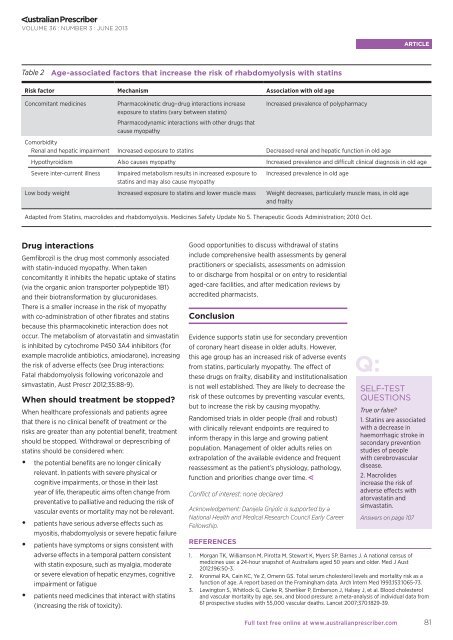download the full PDF issue - Australian Prescriber
download the full PDF issue - Australian Prescriber
download the full PDF issue - Australian Prescriber
You also want an ePaper? Increase the reach of your titles
YUMPU automatically turns print PDFs into web optimized ePapers that Google loves.
VOLUME 36 : NUMBER 3 : JUNE 2013<br />
ARTICLE<br />
Table 2 Age-associated factors that increase <strong>the</strong> risk of rhabdomyolysis with statins<br />
Risk factor Mechanism Association with old age<br />
Concomitant medicines<br />
Pharmacokinetic drug–drug interactions increase<br />
exposure to statins (vary between statins)<br />
Pharmacodynamic interactions with o<strong>the</strong>r drugs that<br />
cause myopathy<br />
Increased prevalence of polypharmacy<br />
Comorbidity<br />
Renal and hepatic impairment Increased exposure to statins Decreased renal and hepatic function in old age<br />
Hypothyroidism Also causes myopathy Increased prevalence and difficult clinical diagnosis in old age<br />
Severe inter-current illness<br />
Impaired metabolism results in increased exposure to<br />
statins and may also cause myopathy<br />
Increased prevalence in old age<br />
Low body weight Increased exposure to statins and lower muscle mass Weight decreases, particularly muscle mass, in old age<br />
and frailty<br />
Adapted from Statins, macrolides and rhabdomyolysis. Medicines Safety Update No 5. Therapeutic Goods Administration; 2010 Oct.<br />
Drug interactions<br />
Gemfibrozil is <strong>the</strong> drug most commonly associated<br />
with statin-induced myopathy. When taken<br />
concomitantly it inhibits <strong>the</strong> hepatic uptake of statins<br />
(via <strong>the</strong> organic anion transporter polypeptide 1B1)<br />
and <strong>the</strong>ir biotransformation by glucuronidases.<br />
There is a smaller increase in <strong>the</strong> risk of myopathy<br />
with co-administration of o<strong>the</strong>r fibrates and statins<br />
because this pharmacokinetic interaction does not<br />
occur. The metabolism of atorvastatin and simvastatin<br />
is inhibited by cytochrome P450 3A4 inhibitors (for<br />
example macrolide antibiotics, amiodarone), increasing<br />
<strong>the</strong> risk of adverse effects (see Drug interactions:<br />
Fatal rhabdomyolysis following voriconazole and<br />
simvastatin, Aust Prescr 2012;35:88-9).<br />
When should treatment be stopped<br />
When healthcare professionals and patients agree<br />
that <strong>the</strong>re is no clinical benefit of treatment or <strong>the</strong><br />
risks are greater than any potential benefit, treatment<br />
should be stopped. Withdrawal or deprescribing of<br />
statins should be considered when:<br />
••<br />
<strong>the</strong> potential benefits are no longer clinically<br />
relevant. In patients with severe physical or<br />
cognitive impairments, or those in <strong>the</strong>ir last<br />
year of life, <strong>the</strong>rapeutic aims often change from<br />
preventative to palliative and reducing <strong>the</strong> risk of<br />
vascular events or mortality may not be relevant.<br />
••<br />
patients have serious adverse effects such as<br />
myositis, rhabdomyolysis or severe hepatic failure<br />
••<br />
patients have symptoms or signs consistent with<br />
adverse effects in a temporal pattern consistent<br />
with statin exposure, such as myalgia, moderate<br />
or severe elevation of hepatic enzymes, cognitive<br />
impairment or fatigue<br />
••<br />
patients need medicines that interact with statins<br />
(increasing <strong>the</strong> risk of toxicity).<br />
Good opportunities to discuss withdrawal of statins<br />
include comprehensive health assessments by general<br />
practitioners or specialists, assessments on admission<br />
to or discharge from hospital or on entry to residential<br />
aged-care facilities, and after medication reviews by<br />
accredited pharmacists.<br />
Conclusion<br />
Evidence supports statin use for secondary prevention<br />
of coronary heart disease in older adults. However,<br />
this age group has an increased risk of adverse events<br />
from statins, particularly myopathy. The effect of<br />
<strong>the</strong>se drugs on frailty, disability and institutionalisation<br />
is not well established. They are likely to decrease <strong>the</strong><br />
risk of <strong>the</strong>se outcomes by preventing vascular events,<br />
but to increase <strong>the</strong> risk by causing myopathy.<br />
Randomised trials in older people (frail and robust)<br />
with clinically relevant endpoints are required to<br />
inform <strong>the</strong>rapy in this large and growing patient<br />
population. Management of older adults relies on<br />
extrapolation of <strong>the</strong> available evidence and frequent<br />
reassessment as <strong>the</strong> patient’s physiology, pathology,<br />
function and priorities change over time.<br />
Conflict of interest: none declared<br />
Acknowledgement: Danijela Gnjidic is supported by a<br />
National Health and Medical Research Council Early Career<br />
Fellowship.<br />
REFERENCES<br />
SELF-TEST<br />
QUESTIONS<br />
True or false<br />
1. Statins are associated<br />
with a decrease in<br />
haemorrhagic stroke in<br />
secondary prevention<br />
studies of people<br />
with cerebrovascular<br />
disease.<br />
2. Macrolides<br />
increase <strong>the</strong> risk of<br />
adverse effects with<br />
atorvastatin and<br />
simvastatin.<br />
Answers on page 107<br />
1. Morgan TK, Williamson M, Pirotta M, Stewart K, Myers SP, Barnes J. A national census of<br />
medicines use: a 24-hour snapshot of <strong>Australian</strong>s aged 50 years and older. Med J Aust<br />
2012;196:50-3.<br />
2. Kronmal RA, Cain KC, Ye Z, Omenn GS. Total serum cholesterol levels and mortality risk as a<br />
function of age. A report based on <strong>the</strong> Framingham data. Arch Intern Med 1993;153:1065-73.<br />
3. Lewington S, Whitlock G, Clarke R, Sherliker P, Emberson J, Halsey J, et al. Blood cholesterol<br />
and vascular mortality by age, sex, and blood pressure: a meta-analysis of individual data from<br />
61 prospective studies with 55,000 vascular deaths. Lancet 2007;370:1829-39.<br />
Full text free online at www.australianprescriber.com<br />
81
















